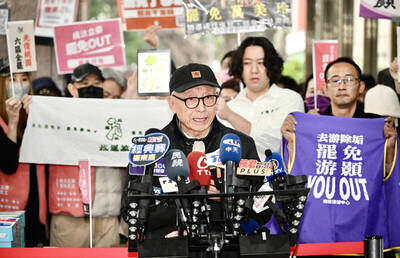Israel's national museum opened two new exhibits on Monday of paintings with a tragic history: They were stolen from the museums and salons of Europe by the Nazis during World War II and never reclaimed by their rightful owners, many of whom perished in the war.
The exhibits are meant to bring to life the dramatic stories behind the art, and perhaps reunite the works with their rightful owners. Visitors who recognize a painting as their own and can prove it can file a claim and potentially take it home.
"It is possible that someone might surface who might find something that belonged to his or her family,'' said James Snyder, the Israel Museum's director, as workers put the final touches on a red-walled gallery at the museum in Jerusalem.

PHOTO :EPA
"Frankly, if that happened, it would really underscore the point that museums are making an effort to close this still-open chapter in the history of the loss that occurred broadly during the war,'' he said.
Last year, an Israeli group in charge of returning the property of Holocaust survivors accused the Israel Museum of not being forthcoming about the art in its possession.
Worldwide, experts say, anywhere between 250,000 and 600,000 pieces of art looted by the Nazis were never claimed and remain in the possession of museums, governments and private collectors.
Consisting of some 80 pieces in all, the exhibits at the Israel Museum include works by masters like Henri Matisse and Georges Seurat, paintings owned by the Rothschild banking family, and other masterpieces worth millions of US dollars.
The first exhibit, Looking for Owners, is made up of 53 paintings on loan from French museums. Put together by a team of Israeli and French curators, it includes several works owned by prominent Nazis like Joachim von Ribbentrop, Hitler's top diplomat.
Most of the French paintings are well-known and have been painstakingly researched, meaning that there is little chance that they will be claimed 60 years after the war's end, Snyder said.
The companion exhibit, Orphaned Art, includes mostly lesser-known paintings and items of Judaica, a small sampling of the some 1,200 pieces given to the Israel Museum decades ago by a group known as the Jewish Restitution Successor Organization, which was entrusted by the Allies with returning unclaimed Jewish property in postwar Europe. The pieces were amassed in Allied collection points set up to process artwork looted by the Nazis.
Also on display are photographs taken after the war showing warehouses with thousands of crates of looted paintings, shelves of sculptures, and dozens of Torah scrolls stacked like logs. The exhibits include computer terminals connected to databases of looted art so visitors can research the pieces on view.
Over the years, the Israel Museum has returned some 20 pieces to owners or heirs, Snyder said.
"Our feeling about them is that our job is to hold them in custody, in a way, as a kind of memorial to their loss, and when the opportunity arises to return a work we are happy to do so,'' Snyder said.
The exhibit of art the museum received from JRSO includes a 19th-century wedding portrait of the beautiful Charlotte de Rothschild, scion of the wealthy Jewish banking family, along with one of her husband and cousin Lionel. The paintings hung in a Jewish nursing home in Frankfurt before they were taken by German troops.
The most famous painting in the JRSO exhibit is one by the early 20th century Austrian master Egon Schiele thought to be worth more than US$20 million.
In the exhibit of art from France, nearly every painting has a story.
Some were seized by the Nazis for inclusion in a museum of European art that Hitler planned to build in Linz, Austria. The Bathers, an 1858 nude by the French realist Gustave Courbet, was purchased by Von Ribbentrop, the Nazi Foreign Minister, in a legitimate transaction with a Parisian art dealer.
The Allies took the painting after the war, and Von Ribbentrop was hanged for war crimes in 1946.
Landscape, the Pink Wall, an early Matisse, was owned by Kurt Gerstein, an SS officer who took an active part in Nazi Germany's methodical murder of Europe's Jews and others they deemed undesirable. Gerstein was responsible for transporting Zyklon B, the gas used for mass killings at the Nazi death camps.
The painting was found by Allied troops hidden in an alcove behind a plaster wall in Gerstein's house after the war. The Nazi officer killed himself in July 1945.
The exhibit also includes several pieces that were successfully restored to their owners, like La Buveuse, a 1658 painting by Dutch master Pieter de Hooch that hung in the salon of financier Edouard de Rothschild in Paris before the war.
"This painting was coveted by Hitler. He knew about it, he wanted it, and he made every effort to get it,'' said Shlomit Steinberg, one of the exhibit's curators. Reclaimed after the war and returned to the Rothschilds, Le Buveuse was later donated to the Louvre by Edouard's daughter.
All in all, the Nazis took 100,000 pieces of art from France during the war. Of those, 60,000 were recovered, and 45,000 of them were returned to their owners or heirs. Most of the rest were auctioned off.
With the new exhibit, the Israel Museum is also making the point that it is forthcoming about the looted art in its possession, in the wake of the accusations leveled against it last year by the Holocaust restitution group.

The Democratic Progressive Party (DPP), Chinese Nationalist Party (KMT), and the country’s other political groups dare not offend religious groups, says Chen Lih-ming (陳立民), founder of the Taiwan Anti-Religion Alliance (台灣反宗教者聯盟). “It’s the same in other democracies, of course, but because political struggles in Taiwan are extraordinarily fierce, you’ll see candidates visiting several temples each day ahead of elections. That adds impetus to religion here,” says the retired college lecturer. In Japan’s most recent election, the Liberal Democratic Party lost many votes because of its ties to the Unification Church (“the Moonies”). Chen contrasts the progress made by anti-religion movements in

Taiwan doesn’t have a lot of railways, but its network has plenty of history. The government-owned entity that last year became the Taiwan Railway Corp (TRC) has been operating trains since 1891. During the 1895-1945 period of Japanese rule, the colonial government made huge investments in rail infrastructure. The northern port city of Keelung was connected to Kaohsiung in the south. New lines appeared in Pingtung, Yilan and the Hualien-Taitung region. Railway enthusiasts exploring Taiwan will find plenty to amuse themselves. Taipei will soon gain its second rail-themed museum. Elsewhere there’s a number of endearing branch lines and rolling-stock collections, some

Last week the State Department made several small changes to its Web information on Taiwan. First, it removed a statement saying that the US “does not support Taiwan independence.” The current statement now reads: “We oppose any unilateral changes to the status quo from either side. We expect cross-strait differences to be resolved by peaceful means, free from coercion, in a manner acceptable to the people on both sides of the Strait.” In 2022 the administration of Joe Biden also removed that verbiage, but after a month of pressure from the People’s Republic of China (PRC), reinstated it. The American

This was not supposed to be an election year. The local media is billing it as the “2025 great recall era” (2025大罷免時代) or the “2025 great recall wave” (2025大罷免潮), with many now just shortening it to “great recall.” As of this writing the number of campaigns that have submitted the requisite one percent of eligible voters signatures in legislative districts is 51 — 35 targeting Chinese Nationalist Party (KMT) caucus lawmakers and 16 targeting Democratic Progressive Party (DPP) lawmakers. The pan-green side has more as they started earlier. Many recall campaigns are billing themselves as “Winter Bluebirds” after the “Bluebird Action”